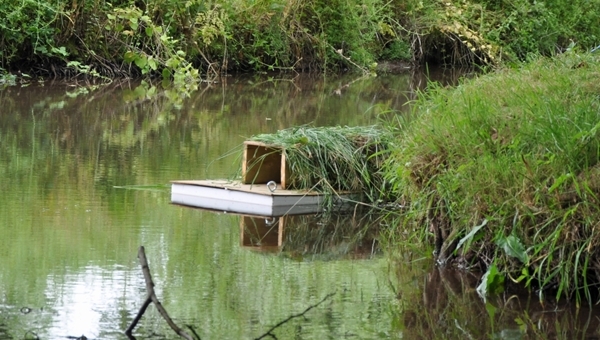By Jodie Case, Predation Research Assistant
In conservation management, Professor John Lawton advised conservation efforts should be ‘bigger, better and more joined up’, and that is exactly what is needed when it comes to American Mink control in the UK.
Since the 1960s, the invasive, non-native American Mink (Neovison vison), through release and escape from fur farms, have amplified predation pressure on various vulnerable species, making control of American Mink an accepted part of conservation management to support many bird species, and in particular, the native, red-listed water vole.
Responding to the growing threat of American Mink to native species, the Game and Wildlife Conservation Trust have led in mink management research for many years. In 2001, the Trust developed the award-winning mink raft as a successful detection and management tool, which is now used by many individuals and conservation organisations.
 The GWCT developed Mink Raft © Pete Thompson
The GWCT developed Mink Raft © Pete Thompson
The development of the mink raft not only allowed mink control to be more targeted, but it also allowed, for the first time, to understand how effective mink control is in a particular area, providing a tool to compare areas with mink and areas with no mink, to gain knowledge of its effect on mink densities.
Between 2006 and 2010, working alongside the release of a wild water vole population to monitor re-establishment success, our predation researchers utilised the mink raft to continuously detect and control American Mink across a river catchment, working sub-catchment to sub-catchment, to understand the density of rafts required and level of control needed to clear the area of mink.
Results from this research showed that mink rafts spaced at 1 per km and checked every two weeks (and once a week during the mating season) successfully cleared the targeted areas within a few months; with the continued persistence of the reintroduced wild water vole population during the same period also suggesting effective mink control.
There is, however, still a great deal more to know about the movements of American Mink and their spatial scales of immigration, but what this existing research has taught us is that with a continuous, joined up and systematic trapping strategy, substantial levels of control can be made on this damaging non-native species.
Just as important, knowledge of where mink control is being carried out is also needed, to attempt to join up control efforts throughout catchments. Thankfully, a new initiative called the MinkMApp is now tackling this knowledge gap, using a smartphone approach to streamline mink control.
Across the country there are local scale mink control projects being carried out, but also large areas where the status of mink control is simply unknown. The MinkMApp provides an exciting opportunity to understand where mink control is happening, the scale at which it is being carried out and crucially, areas where control is not taking place.
This new approach offers the ability to join up efforts through a database of map locations where mink control is present, to encourage the initiation of new projects and to develop a much-needed, joined up, nationwide strategy.
If you are currently carrying out mink control in your area, do consider securely sharing your efforts with the MinkMApp team, to help grow a joined up approach to mink control - www.minkmapp.uk

See below to find out more about mink rafts and GWCT mink management courses:
- GWCT Mink Management Courses – contact lherring@gwct.org.uk
- GWCT Mink raft guidelines >